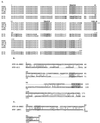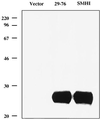The collagen repeat sequence is a determinant of the degree of herpesvirus saimiri STP transforming activity
- PMID: 10933720
- PMCID: PMC112343
- DOI: 10.1128/jvi.74.17.8102-8110.2000
The collagen repeat sequence is a determinant of the degree of herpesvirus saimiri STP transforming activity
Abstract
Herpesvirus saimiri (HVS) is divided into three subgroups, A, B, and C, based on sequence divergence at the left end of genomic DNA in which the saimiri transforming protein (STP) resides. Subgroup A and C strains transform primary common marmoset lymphocytes to interleukin-2-independent growth, whereas subgroup B strains do not. To investigate the nononcogenic phenotype of the subgroup B viruses, STP genes from seven subgroup B virus isolates were cloned and sequenced. Consistent with the lack of oncogenic activity of HVS subgroup B viruses, STP-B was deficient for transforming activity in rodent fibroblast cells. Sequence comparison reveals that STP-B lacks the signal-transducing modules found in STP proteins of the other subgroups, collagen repeats and an authentic SH2 binding motif. Substitution mutations demonstrated that the lack of collagen repeats but not an SH2 binding motif contributed to the nontransforming phenotype of STP-B. Introduction of the collagen repeat sequence induced oligomerization of STP-B, resulting in activation of NF-kappaB activity and deregulation of cell growth control. These results demonstrate that the collagen repeat sequence is a determinant of the degree of HVS STP transforming activity.
Figures








Similar articles
-
Herpesvirus saimiri.Philos Trans R Soc Lond B Biol Sci. 2001 Apr 29;356(1408):545-67. doi: 10.1098/rstb.2000.0780. Philos Trans R Soc Lond B Biol Sci. 2001. PMID: 11313011 Free PMC article. Review.
-
The divergence between two oncogenic Herpesvirus saimiri strains in a genomic region related to the transforming phenotype.Virology. 1990 Jun;176(2):505-14. doi: 10.1016/0042-6822(90)90020-r. Virology. 1990. PMID: 2161148
-
Role of cellular tumor necrosis factor receptor-associated factors in NF-kappaB activation and lymphocyte transformation by herpesvirus Saimiri STP.J Virol. 1999 May;73(5):3913-9. doi: 10.1128/JVI.73.5.3913-3919.1999. J Virol. 1999. PMID: 10196286 Free PMC article.
-
Genetic variation of herpesvirus saimiri subgroup A transforming protein and its association with cellular src.J Virol. 1997 May;71(5):3817-25. doi: 10.1128/JVI.71.5.3817-3825.1997. J Virol. 1997. PMID: 9094657 Free PMC article.
-
Cell transformation by Herpesvirus saimiri.J Cell Physiol. 2005 May;203(2):305-18. doi: 10.1002/jcp.20225. J Cell Physiol. 2005. PMID: 15389624 Review.
Cited by
-
The Apis mellifera Filamentous Virus Genome.Viruses. 2015 Jul 9;7(7):3798-815. doi: 10.3390/v7072798. Viruses. 2015. PMID: 26184284 Free PMC article.
-
Herpesvirus saimiri.Philos Trans R Soc Lond B Biol Sci. 2001 Apr 29;356(1408):545-67. doi: 10.1098/rstb.2000.0780. Philos Trans R Soc Lond B Biol Sci. 2001. PMID: 11313011 Free PMC article. Review.
-
Activation of Stat3 transcription factor by Herpesvirus saimiri STP-A oncoprotein.J Virol. 2004 Jun;78(12):6489-97. doi: 10.1128/JVI.78.12.6489-6497.2004. J Virol. 2004. PMID: 15163742 Free PMC article.
-
Tyrosine phosphorylation of the Tio oncoprotein is essential for transformation of primary human T cells.J Virol. 2005 Aug;79(16):10507-13. doi: 10.1128/JVI.79.16.10507-10513.2005. J Virol. 2005. PMID: 16051843 Free PMC article.
-
Growth transformation of human T cells by herpesvirus saimiri requires multiple Tip-Lck interaction motifs.J Virol. 2006 Oct;80(20):9934-42. doi: 10.1128/JVI.01112-06. J Virol. 2006. PMID: 17005671 Free PMC article.
References
-
- Biesinger B, Trimble J J, Desrosiers R C, Fleckenstein B. The divergence between two oncogenic herpesvirus saimiri strains in a genomic region related to the transforming phenotype. Virology. 1990;176:505–514. - PubMed
Publication types
MeSH terms
Substances
Grants and funding
LinkOut - more resources
Full Text Sources

